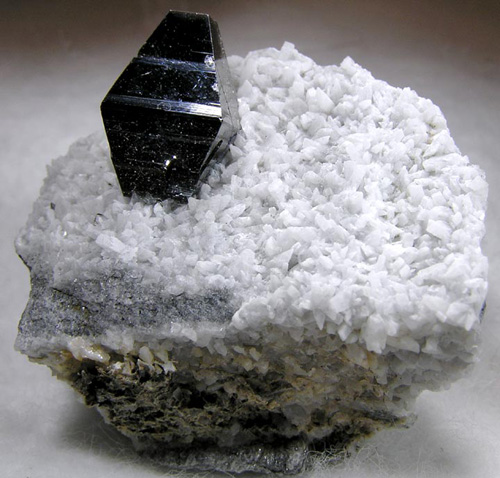The Mineral anatase

Anatase is a relatively uncommon yet very aesthetic form of titanium dioxide. It forms distinct and unique crystals, which are usually microscopic to very small, though a few localities have produced larger crystals. Anatase is polymorphous
with the more common Rutile, as well as Brookite. It is often replaced entirely by Rutile, forming interestingly shaped Rutile pseudomorphs after Anatase. The name Anatase is derived from the Greek word anatasis, which means elongation, in allusion to its elongated crystal habit (in relation to Rutile.)
Color
Dark blue, navy blue, black, reddish-brown, brown, honey yellow, orange. Rarely red, green, or gray. Occasionally in two colors or in lighter and darker color splotches or zones.
Crystal System
Tetragonal
Crystal Habits
As steeply formed dipyramidal crystals, or in clusters of such crystals. Crystals may have sharp pointed terminations, or they be modified or partially flattened. Also pseudo-octahedral, tabular, in highly modified complex crystals, in scepter-formed habits, and in rounded waterworn crystals. Crystals are usually heavily striated cross-wise, and may have interesting tapering and accordion-like growths. X-shaped twins do exist but are very rare.
Uses
Anatase is a rare collector's mineral and is highly desired by collectors, especially when in good crystals.
Noteworthy Localities
Europe contains some of the best localities for Anatase. Exceptionally large dark crystals come from Matskorhae and Dyrfonni, in Hardangervidda, Norway. In France, two important Anatase localities are Bourg d'Oisans, Isère, Rhone; and La Madeleine pass, Savoie. Good crystals are well-known from several regions in Switzerland, specifically the Binntal, Wallis; the St. Gotthard Massif, Ticino; and Tujetsch (Tavetsch), Grischun. The Italian Alps also contains many Anatase localities where well-formed tiny crystals have been found, especially in the Val d'Ossola, Piedmont. A classic British locality is Twll Maen Grisial, Prenteg, Wales.
Well formed, lustrous Anatase crystals have come from a newer find in Kharan, Balochistan, Pakistan. Minas Gerais, Brazil, has several important localities, where large crystals come from Diamantina, in the Jequitinhonha valley; the Cuiabá District, Gouveia; and in scepter-shaped formations in Dattas.
In the U.S., Anatase localities include the Lot Mine, Gunnison Co., Colorado; the Yates Brooks Farm, Lattimore, Cleveland Co., North Carolina; the County Line Quarry, Wrightsville, York Co., Pennsylvania; and Somerville, Middlesex Co., Massachusetts. Large crystals and interesting pseudomorphs have come from the the Jones Mill Quarry and Perovskite Hill, Magnet Cove, Hot Spring Co., Arkansas.
Distingushing Similar Minerals
Babingtonite - Different crystal habits, lacks any transparency.
Sphalerite - Different crystal habits, lower hardness.
Zircon and Spinel- Much harder.
Sapphire - Much harder, forms in hexagonal crystals.
Xenotime - May be very difficult to distinguish.